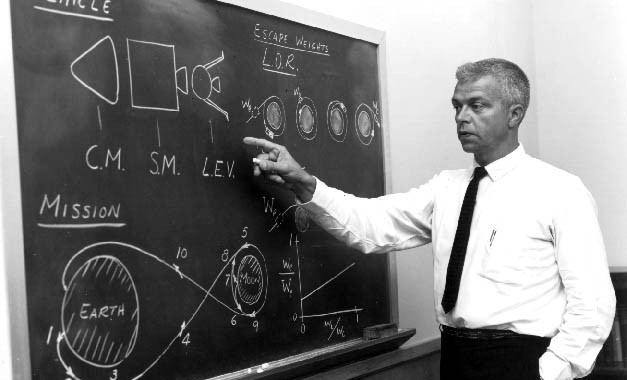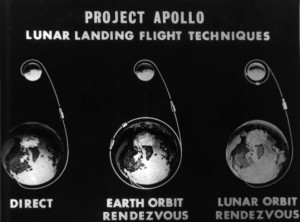
Lunar Orbit Rendezvous explained by John Houbolt. Credit: NASA
June 30, 2010 Vol. 3, Issue 6
On June 7, 1962, Dr. Wernher von Braun tipped the scales in a heated debate of how to put men on the moon.
The heat was on. Thirteen months had elapsed since President Kennedy declared that the United States would land men on the moon by the end of the decade. NASA, created less than four years earlier, was charged with getting them there. But NASA didn’t have a clear path to the moon.
Just as there are several ways to reach the summit of Mt. Everest, there were multiple ways to get to the moon: 1) blast straight off the ground on a direct path to the surface and return the same way; 2) launch into Earth orbit, refuel and assemble the spacecraft, and then take the entire craft to the moon; 3) or launch into lunar orbit and land a small lander on the lunar surface while the remaining spacecraft stays in orbit.
The first path—called “direct ascent”—was initially the most popular option. However, it became clearer with more discussion that this option wouldn’t meet the President’s deadline. The twelve-million-pound-thrust, battleship-sized “Nova” rocket didn’t exist yet and was sure to run over schedule.
This left the other two approaches: the Earth-orbit rendezvous (EOR), the second favorite, and lunar-orbit rendezvous (LOR), the “dark horse.” By the beginning of 1962, determining the path to the moon would come down to the two main manned spaceflight centers: Marshall Space Flight Center (MSFC) and the Manned Spacecraft Center (now Johnson Spaceflight Center). However, when Brainerd Holmes, director of the Office of Manned Space Flight, tasked his deputy director, Joseph Shea, with determining the best path, the two centers were decidedly split. Shea would spend the next six months coordinating meetings, initiating studies, and seeking expert advice to get MSFC and MSC to agree on one path.
Marshall favored the EOR approach. It called for launching two pieces of hardware independently on the Saturn V rockets under development. The two pieces would assemble together in Earth orbit to make a lunar mission vehicle, fuel up, and head for the moon. Astronauts would have to land the entire craft on the moon and then return to Earth. While this approach offered the advantage of using a launch vehicle that was already in development (unlike the direct ascent approach), there wasn’t a clear concept of how to land the large mission vehicle on the unknown surface of the moon.

The three principal contending lunar landing techniques: direct ascent (left), earth-orbit rendezvous (center), and lunar-orbit rendezvous (right). Credit: NASA
Houston, after several years of persistent advocacy by John Houbolt, an engineer at Langley Research Center, supported the LOR approach. It involved firing three spacecraft (command module, service module, and lunar module) aboard one Saturn V rocket into Earth orbit. Once there, the last stage of the Saturn boosted the spacecraft on a lunar trajectory and eventually into orbit. Only the lunar module would go down to the surface. It would then return and re-dock with the orbiting command module in the top-half of the lunar module (leaving the base on the moon). The astronauts would return to Earth in the command module, while the remainder of the lunar module was ejected into space.
The LOR option had lots of pros. It required less fuel and new technology. It didn’t require a rocket larger than the gargantuan Saturn V. It employed just a small lunar lander, and each of the modules could be tailored independently. But there was a drawback. LOR didn’t offer a rescue option if the tricky rendezvous failed. The thought of three astronauts out of help’s reach 240,000 miles from home didn’t sit well with the engineers.
The complexity of this decision rested upon politics, money, schedule, mass, fuel, technology, center culture, work distribution, and, most importantly, human lives. As June approached and the path debate was still unresolved, Shea saw that the LOR approach really was the best decision, but he wanted unanimity. This meant appealing to Marshall’s director, Dr. Wernher von Braun.
This wasn’t an easy task. Von Braun worried about the loss of relevance and work Marshall would suffer if the LOR approach won out. Despite several meetings, studies, and even campaigns (one of which was called “Charlie Frick’s Road Show,” named after Charles Frick from Houston, stopped by Marshall on the way to Washington), von Braun’s decision remained firm.
But that changed on June 7, 1962. For six hours, Marshall representatives presented their argument for using the EOR approach. At the end of the day-long meeting, after months of steadfastness, von Braun stood up and read from a sheet of paper he had been scribbling on over the course of the day:
We at the Marshall Space Flight Center readily admit that when first exposed to the proposal of the Lunar Orbit Rendezvous Mode we were a bit skeptical—particularly of the aspect of having the astronauts execute a complicated rendezvous maneuver at a distance of 240,000 miles from the earth where any rescue possibility appeared remote. In the meantime, however, we have spent a great deal of time and effort studying the [three] modes, and we have come to the conclusion that this particular disadvantage is far outweighed by [its] advantages.
We understand that the Manned Spacecraft Center was also quite skeptical at first when John Houbolt advanced the proposal of the Lunar Orbit Rendezvous Mode, and that it took them quite a while to substantiate the feasibility of the method and fully endorse it.
Against this background it can, therefore, be concluded that the issue of “invented here” versus “not invented here” does not apply to either the Manned Spacecraft Center or the Marshall Space Flight Center; that both Centers have actually embraced a scheme suggested by a third source….I consider it fortunate indeed for the Manned Lunar Landing Program that both Centers, after much soul searching, have come to the identical solutions.
In the weeks that followed, the final decision to go to the moon using the LOR approach made its way to the desk of Administrator James Webb (a proponent of the direct ascent approach). On June 22, 1962, the Manned Space Flight Management Council announced in favor of the LOR approach.
Starting July 16, 1969, NASA flew eight missions to the lunar surface, and although Apollo 13 didn’t land on the moon, all the astronauts made it home safely.
Read about John Houbolt and the genesis of the lunar-orbit rendezvous concept in Enchanted Rendezvous by James Hansen.
NASA APPEL Flickr slideshow on Project LOLA (Lunar Orbit and Landing Approach)
View slideshow on Flickr, where you may click Show Info to see detailed image captions.
Lunar Orbit Rendezvous explained by John Houbolt.
Featured Photo Credit: NASA





